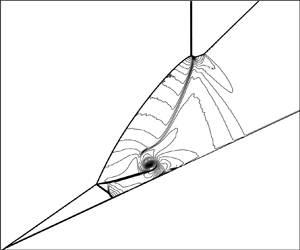Article contents
Reflection of rightward moving shocks of the first and second families over a steady oblique shock wave
Published online by Cambridge University Press: 11 February 2022
Abstract

The reflection of rightward moving shocks (RMSs) belonging to the first and second families, over an initially steady oblique shock wave (SOSW) produced by a wedge, is studied in this paper. Various possible combinations of primary reflection (reflection at the intersection point of the RMS and the SOSW) and secondary reflection (reflection, on the wedge, of reflected shock waves of the primary reflection) are identified and the transition conditions are studied. For an RMS of the first family, the shock reflection problem can be shown to be equivalent to a shock interference problem. If the wedge angle is large, then the problem is equivalent to a shock interaction problem with two incident shock waves of the same family so that we have type VI, type V and type IV shock interferences. Interestingly, when the wedge angle is small enough, deflection angle reversal is observed for the SOSW so that the right part of the SOSW can no longer be regarded as one incident shock wave. It is now the left part of the SOSW that becomes one incident shock wave. As a result, for a small wedge angle, type I or type II shock interference is observed. If the RMS belongs to the second family, then the primary reflection may have regular and Mach reflections, and one reflected shock of this primary reflection reflects over the wall as another pseudo-steady shock reflection, while the other reflected shock wave may be smooth or have a kink or a triple point, as in single, transitional and double Mach reflection of pseudo-steady shock reflection.
JFM classification
- Type
- JFM Papers
- Information
- Copyright
- © The Author(s), 2022. Published by Cambridge University Press
References
REFERENCES
- 4
- Cited by



